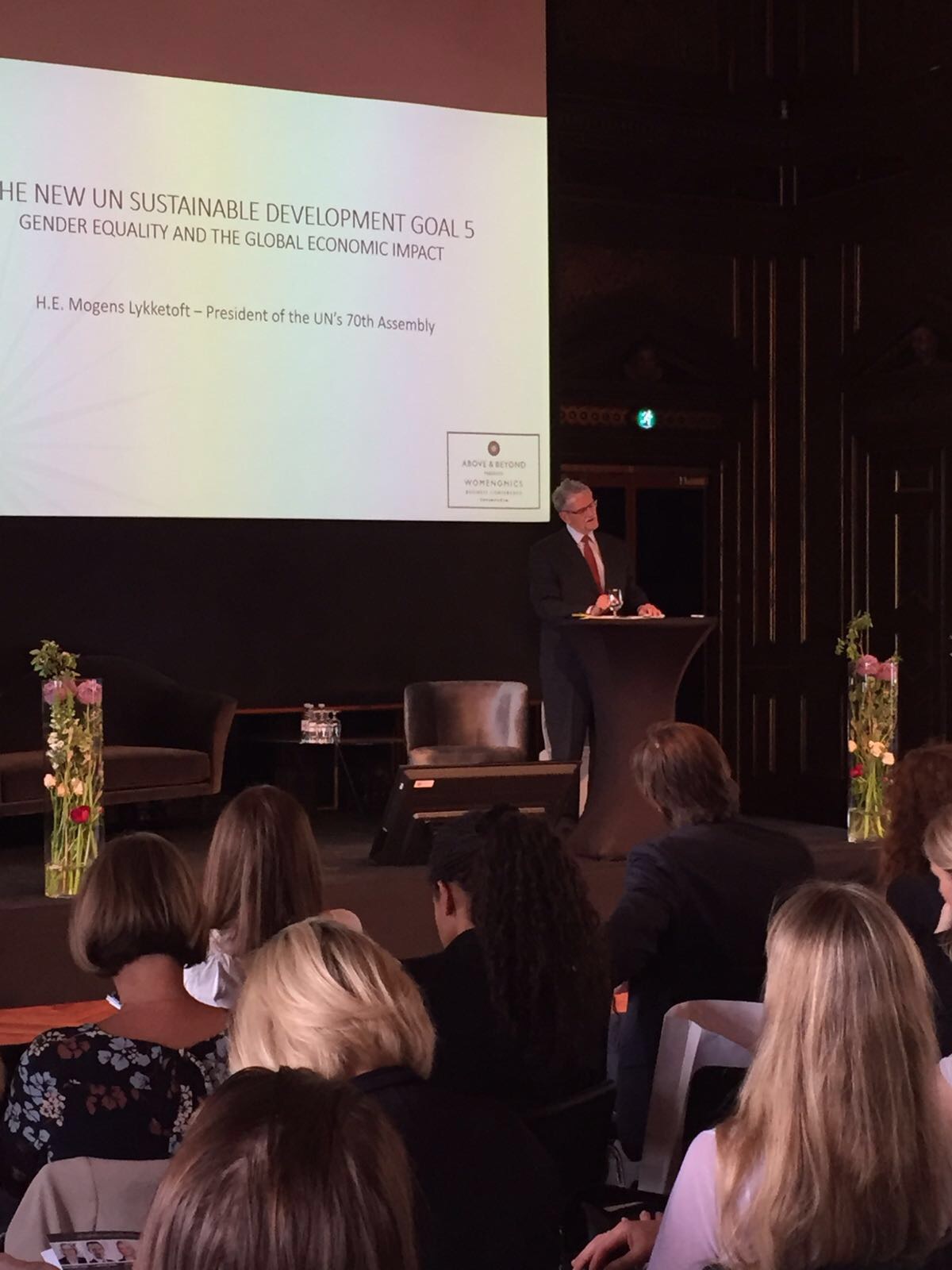Statement by H.E. Mr Mogens Lykketoft, President of the 70th session of the General Assembly, at Womenomics Business Conference
18 May 2016
 Good afternoon ladies and gentlemen.
Good afternoon ladies and gentlemen.
It is a pleasure to be here with you today.
In September last year, all 193 UN member states signed up to the 2030 Agenda for Sustainable Development.
In doing so, they united around a common vision for our collective future; around a manifesto to transform our world for people and planet.
As you may know, at the heart of the 2030 agenda are 17 deeply inter-connected Sustainable Development Goals that seek to advance four major shifts in our world:
– To end poverty and ensure everyone has a fair chance in life;
– To deliver shared prosperity including by urgently shifting to economic pathways that will keep global temperatures at least below 2degrees Celsius and therefore avert the worst impacts of climate change.
– To protect our natural environment.
– And to ensure that people everywhere enjoy justice, peace and human rights.
And central to achieving these broad objectives is gender equality.
It is captured through targets across all 17 goals as well as through a dedicated goal, Goal 5.
In doing so, the 2030 Agenda says loud and clear that gender equality is not only fundamental in its own right, it is an absolute precondition for the other goals too.
Why?
Because – as I am sure you have been discussing here already – investing in women and girls and achieving gender equality is not just the right thing to do; it is good economics, good for business, and good for society.
This is the rationale behind the SDGs.
And it is the message from the well-known McKinsey report which estimates that in a “full potential” scenario in which women play an identical role in labor markets to that of men, as much as 28 trillion USD could be added to global annual GDP by 2025.
That is roughly equivalent to the size of the Chinese and US economies combined today.
In a world that is crying out for a boost to economic activity, it would be bordering on reckless to ignore this opportunity.
After world leaders signed up to the SDGs, therefore, the real question is not whether gender equality is good for the global economy but how to unleash its potential?
How to address the situation where the chances for women to participate in the labour market globally remain almost 27% lower than those for men?
How to tackle deeply rooted norms that say men should control women or that masculine traits are more suited to the market economy than feminine traits?
How to change practices that mean that, on average, women earn 77% of what men earn?
These are tough questions and achieving the SDGs as they relate to gender equality will not be easy.
But it can and must happen.
A quick look back at what happened here in Denmark in my own lifetime, for example, demonstrates that this is the case.
_______________
As many of you are aware, in the 1960s, when I myself was beginning third level education, a mere 5% of all 25 year old women completed a long university degree compared to 16% of men.
In the same period, women accounted for only 28% of those employed in all
professions.
But today, despite the fact that there are far fewer women in the top business and government jobs than there should be, our society has been transformed.
76% of women are now participating in the labour market compared to 81% of men.
And 96% of women receive some form of tertiary education.
So how did this change happen?
Of course, first and foremost it happened because women demanded their rights.
It happened also because of a political and social consensus driven in part by labour unions.
It happened because of strong economic growth and because our continent enjoyed a prolonged period of stability and peace.
It happened because of sustained investment in the social sectors – in education, health and social protection.
And it happened because successive Danish governments brought forward specific legislative and policy changes that made it easier for women to enter the labour market:
In 1960, for example, a law entitling women to 14 weeks of maternal leave was introduced.
In 1966, contraception became more accessible.
In 1973, abortion on demand was legalised up until the 12th week.
In 1976 and 78, we had the Equal Pay and the Equal Treatment Acts respectively.
In 1984, men were given the right to parental leave which 20 years later increased up to 52 weeks in total for both parents.
Then in 1988, we moved on to the Equal Opportunities Act and finally, in 2000, we brought in the first ever Gender Equality Act.
___________
And while Denmark still has a great deal to do, particularly in terms of getting more women into higher positions in both government and business, it’s overall performance in terms of achieving gender equality in the economy these past 50 years demonstrates that dramatic improvements can be made, when we put our minds to it.
Today, the scale of the task before us globally is immense.
In fact, if current trends prevail, it will take more than 70 years before gender wage gaps are closed completely.
But on the other hand, we have the resources, skills, knowledge, technology and the empowered and connected people to make this happen and to make it happen during the lifetime of the SDGs.
Which is where all of you come in.
During these first few years of the SDGs, we need to generate buy-in and action from across society – from civil society, academia, the media, labour unions, the private sector, financial institutions and others.
In particular, we need businesses across the globe to embrace the issue of women’s economic participation, to remove the glass ceiling and to join us on this journey – whether they be small and medium enterprises, large multi-nationals or players in the global finance world.
We need new energy and new coalitions, including those emerging from discussions like this one.
Which reminds me of what Canada’s Prime Minister, Mr. Justin Trudeau, said while attending the Commission on the Status of Women in the UN last March.
“I am a feminist,” he said – and the room started cheering.
More importantly, he continued, “and I’ll keep saying it until the only response I get is a shrug.”
That for me sends the strongest message.
With the Sustainable Development Goals, we have a framework to rally around, to mobilize funds and to drive action that will hopefully get us closer to that reality.
But we have to keep going until we succeed.
It is, as I said at the beginning, good economics, good for business, and good for society.
Thank you.

